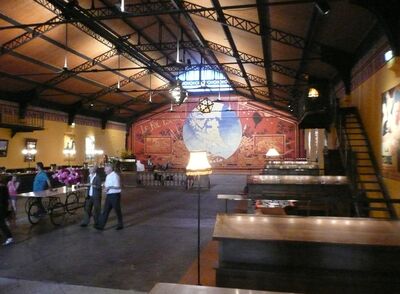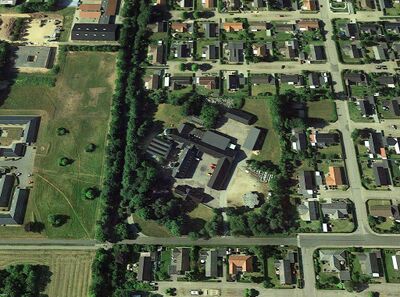Shelter or Building
Theatre artists work within organisations and buildings that are not always suited to their artistic purpose. Sometimes, they set up their own companies and find their own spaces, to make the most suitable environment for creating their work.
There is a tension in most theatre companies. On the one hand, theatre is made by artists – directors, designers, actors, technologists – who are motivated to experiment, to collaborate, to work in close, personal relationship with each other to make their art. On the other hand, theatre companies and theatre buildings operate as corporate entities, that have budgets, funders, management, contractual arrangements, employees, legal obligations. Mostly, the corporate identity is dominant, and artists make work within the institutional structures as best they can. Sometimes, artists set up their own companies, and run them in new ways, better suited to their particular artistic ethos. Two such companies are the Théâtre du Soleil at the Cartoucherie, a former munitions factory in the Bois de Vincennes in Paris, and the Odin Teatret, based at a former farm in Holstebro in Denmark.
In 1964 the young Odin Teatret company arrived at a farm in Saerkjaergaard, a suburb of Holstebro, founded by Eugenio Barba. The members were four young people who had been rejected from the Oslo State Theatre School. In the early days it created street theatre; today it has a permanent and paid staff of about 20 people, including actors, technicians and administrative staff.
The French theatre collective Théâtre du Soleil was founded in 1964 by Ariane Mnouchkine. The international company has its main venue at the gates of Paris, in the old, abandoned munitions factory of Vincennes (La Cartoucherie), where other theatre groups are based today. The Théâtre du Soleil sees itself as a politically active theatre that wants to influence social reality in a critical way. It is oriented towards the theatre of the Far East and Greek tragedy, as well as the traditions of popular theatre such as the Commedia dell’arte.
And in both spaces, territories are liberated from everyday life. Crossing the entrance door of both spaces gives the impression of entering a different space and time, an emotion that Soleil seeks to reinforce through a protocol of rituals, the first of which is the welcome. Thus, Ariane Mnouchkine, the director and alma mater of the troupe, often welcomes the audience by interrupting the spectators’ entrance.
The feeling of being part of a community, of constituting an audience, is present in the companies’ rooms. At the Odin, in a warm, welcoming atmosphere, upholstered with carpets and with the presence of posters showing the life of the company. At the Soleil, the foyer, which is also the dining room, is a particularly well cared for area, changing according to the work being staged. It is perhaps this desire to create a community of audience and artists that is the reason for opening the dressing rooms in the Cartoucherie to the view of the spectators, another singularity of the company's spaces.
Theatre is a space and a time of encounter, of the audience with itself and with the work of art. Also, the theatrical work of the companies is also constructed as an encounter of genres and theatrical traditions – a new form of theatre needs new kinds of theatre-makers. The Soleil actors explore a diverse range of techniques: clowning, commedia dell’arte, kabuki, puppetry... Arts, trades, industry make up the organic body that gives life to theatre.
The Odin Teatret and the Théâtre du Soleil are builders’ houses. The halls of the farm and those of the Cartoucherie offered the space, the proximity necessary for collective creative work. In the Teaterlaboratorium, as Eugenio Barba called it, and in the Theatre-Workshop required by the Soleil in the Cartoucherie, the structure of the old pavilions could be adapted to house storage, workshops for scenery, costumes or props, office space, a magnificent library and study centre for theatrical anthropology in the Odin’s house in Holstebro, or kitchens and dining rooms. The kitchen and dining rooms of the companies are as important as the workshops or even the stage.
In his article L’abri ou L’édifice (The Shelter or the Building, 1978), Antoine Vitez was able to capture very well the antithetical condition that the architecture of theatres can assume, either as a ‘perfect technical instrument’ building, more or less monumental, an eloquent sign that seeks to distinguish itself, or as a refuge that shelters theatrical activity. The halls of the former Holstebro farm, enlarged over time, and those of the Cartoucherie, offered the refuge sought by the companies. They offered just the right place, ready to host any stage proposal, they formed an empty space, though not a neutral one. The Soleil’s treatment of the theatrical space also avoids the black box, the tabula rasa. The rooms must be transformable, but they must not become a theatre-machine. The technique is used, but not exhibited. In the case of Odin Teatret and Théâtre du Soleil, and other companies founded by artists with particular intentions, the theatre company is organised, and the physical environment arranged, to be the best possible context within which to make the work.

